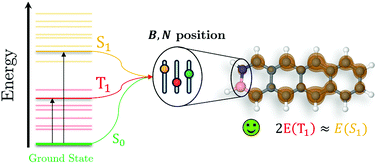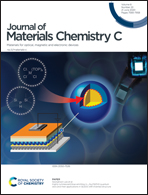A systematic analysis of excitonic properties to seek optimal singlet fission: the BN-substitution patterns in tetracene†
Abstract
The development of efficient organic-based photovoltaic devices is a vibrant area of research with the potential of providing a cheap source of sustainable energy to society. The attainable power conversion efficiencies could be strongly enhanced via the singlet fission (SF) mechanism, a quantum mechanical phenomenon that potentially doubles the number of electron–hole pairs in a photoexcitation process by splitting a high energy singlet into two triplets. Biradicaloid molecules are particularly appealing for SF applications due to the possibility of controlling the balance between open-shell and closed-shell resonance structures via chemical modifications, which open new opportunities to fine tune the singlet and triplet excitation energies, and thus maximize the SF efficiency. Recently, we have shown that doping acenes with boron (B) or nitrogen (N) atoms leads to a large modulation in its biradicaloid nature at the ground-state. Herein, this previous study is extended to the case of asymmetric substitutions by introducing a BN-pair in a tetracene molecule to form azaborine analogues of acenes. The consequences of the chemical doping on the excitonic properties of tetracene are investigated through high-level multireference calculations. From a pool of 60 proposed BN-tetracene chromophores, we identify 15 new promising candidates for SF as they satisfy the energy level matching conditions involving the low-lying singlet and triplet states of a monomer. Still, some of these compounds show good chemical stability as evidenced by their modest biradical character. These results are interpreted in terms of aromaticity changes, charge transfer effects and exciton properties. More generally, this study shows how the energetics of singlet fission materials can be dramatically altered by using fairly simple chemical substitutions and provides detailed insight into the underlying relationships between the molecular structure, the electronic structure, and the excited state energies.



 Please wait while we load your content...
Please wait while we load your content...